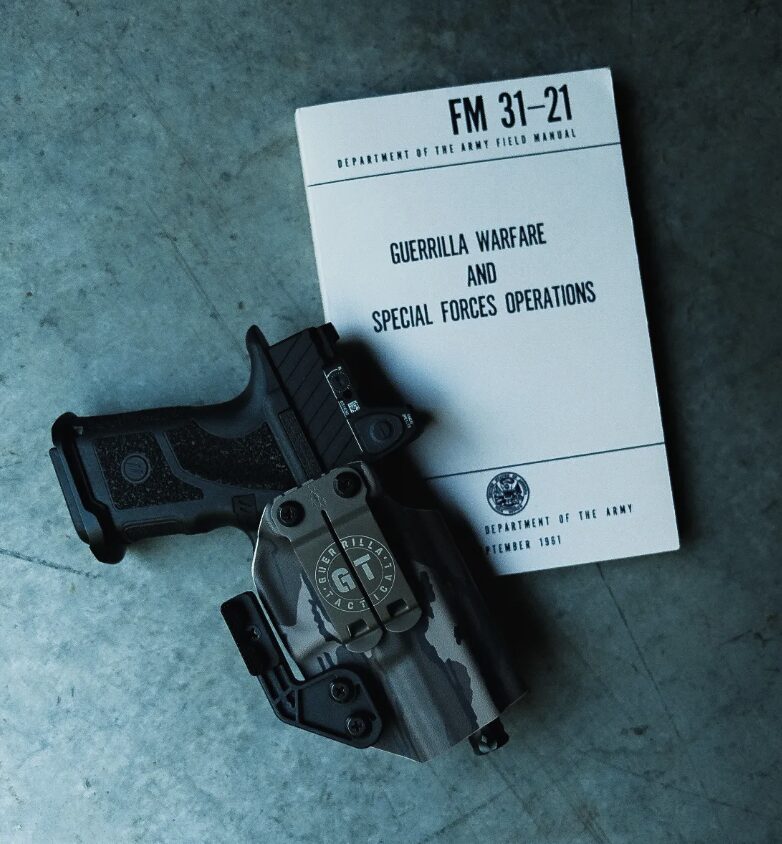
An Overview for Responsible Civilian Study
The Guerrilla Warfare & Special Forces Operations Handbook is a 257-page field manual that presents principles, case studies, and reference materials on unconventional warfare, resistance operations, and special forces tactics. While the handbook’s subject matter touches on military techniques, many readers — researchers, historians, outdoor educators, and preparedness-minded civilians — find value in studying its high-level lessons for nonviolent, legal, and ethical purposes.
Below our team at Guerrilla Tactical is going to explain what the handbook contains, who can benefit from it, and how to approach it responsibly.
What’s Inside the Handbook (High Level)

The manual is organized to teach foundational concepts rather than provide step-by-step operational instructions. Key content areas include:
- Fundamentals of resistance and irregular warfare — historical context, principles of asymmetric conflict, and case studies that illuminate why and how movements emerged.
- Planning and leadership frameworks — high-level guidance on decision-making, risk assessment, and organizing teams.
- Logistics & intelligence (conceptual) — overview of planning logistics and information management from a systems perspective (not procedural how-tos).
- Infiltration & escape (contextual) — historical accounts and ethical discussions about movement, mobility, and personal safety.
- Visual aids — charts, maps, and images that clarify concepts and timelines.
Important: This overview intentionally avoids operational detail. The handbook itself includes historical material intended for study; readers should not use it to attempt illegal or violent acts.
Why Civilians Study This Handbook — Lawful, Constructive Uses

1. Historical and Academic Research
Scholars, students, and history enthusiasts use the manual to better understand 20th- and 21-century conflicts, resistance movements, and the evolution of special operations. It’s a primary-value reference for comparative studies and thesis work.
2. Leadership and Team-Management Lessons
The book’s sections on planning, command structures, and resilience translate to civilian leadership contexts. Emergency response coordinators, NGO managers, and community organizers can extract lessons on decision making under pressure, delegation, and contingency planning.
3. Community Preparedness and Disaster Resilience
Concepts about logistics, communication, and redundancy are useful for civilian emergency preparedness (natural disasters, infrastructure failures). The handbook’s systems perspective helps planners think about supply chains, situational awareness, and coordinated response without any violent intent.
4. Outdoor Skills and Navigation (Ethical Learning)
High-level navigation, map reading, and survival mindset content can benefit hikers, search-and-rescue volunteers, and outdoor educators — provided such knowledge is used ethically and legally.
5. Critical Thinking and Risk Assessment
Studying unconventional warfare encourages readers to analyze information critically, assess risks, and understand how misinformation and social dynamics can escalate conflict. For example, if you are faced in a life or death situation, you don’t want to just draw your firearm and start shooting, you need to think quickly and clearly.
These critical skills are valuable for civic engagement, journalism, and public policy.
Responsible Reading: Ethics, Legality, and Safety
Now with a book like this, it is not necessarily a call to action to wage war against anyone or any organization. You can’t just sling your firearms around and expect to not face any consequences.
- Use it for study, not action. The handbook is intended for educational/historical purposes; using material to plan harm is unlawful and unethical.
- Respect local laws. Many countries have statutes governing possession of certain manuals or carrying out paramilitary activity. Know and follow the law.
- Emphasize nonviolence. Civilian applications should focus on disaster preparedness, scholarship, and lawful community organizing.
- Contextualize history. Read the manual alongside reputable historical sources and ethical analyses to avoid simplistic or romanticized readings.
How to Cite and Integrate the Handbook in Civilian Projects

- Use it as a historical primary source in academic citations.
- Pair its case studies with peer-reviewed scholarship when constructing research or presentations.
- Extract high-level management frameworks for tabletop exercises in emergency planning — but do not replicate operational tactics.
Conclusion
The Guerrilla Warfare & Special Forces Operations Handbook is a dense, reference-style manual whose greatest civilian value lies in historical study, leadership lessons, and improving community resilience. When read responsibly — with attention to ethics and law — it can inform safer, smarter civilian planning, academic research, and preparedness activities without endorsing unlawful conduct.
Be sure to check out Guerrilla Tactical on Instagram and Youtube!



